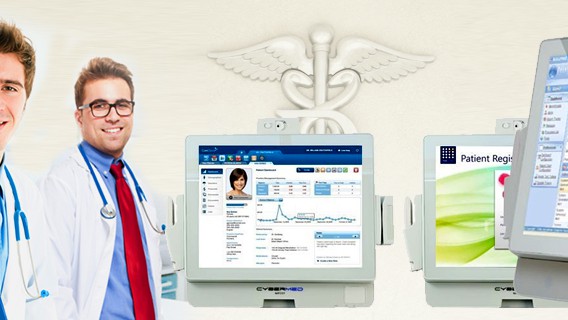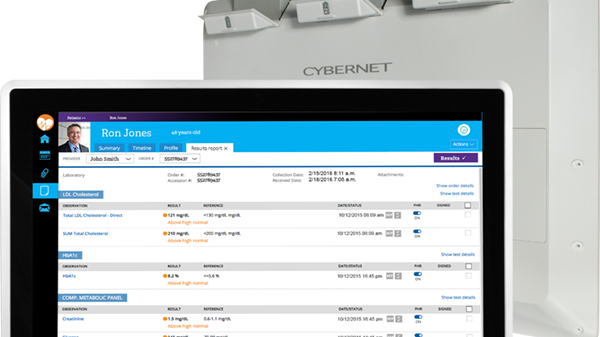They’re called workstations on wheels, or WOWs: mobile medical carts, either powered or non-powered, that allow nurses and other personnel to move from bedside to bedside with medical computer systems in tow. They’re rapidly becoming a staple in healthcare operations of all varieties, part of a larger wave of technological innovation that is revolutionizing the way we treat the sick and injured.
WoWs are designed not only to enhance the efficiency of hospital staff, but to provide better care for patients and improve the overall treatment experience. They come with a variety of designs and features, but all of them should have the same basic goals in mind: saving your staff time and energy, and letting them focus on patient care. Here’s a quick list of 4 ways a good medical equipment cart can do that.
Patient Charting with a Computer on Wheels
Article Guide
Paperwork is the bane of most hospital staff members and patient charting can be an extremely time-consuming process. A recent study by the National Institute of Health maintained that nurses spend an average of two hours a day on charting and similar record-keeping duties. Paper charts need to organize and unify a great deal of information, which makes them extremely vulnerable to human error. Ideally, charting should take place very quickly after visiting the patient: within an hour or so. The more time that goes by, the easier it is to make mistakes and the more likely those mistakes will have an impact on other aspects of your operation.
Electronic medical records (EMR) provide a theoretical solution to the problem, but they need to be accessed by a computer station, which isn’t always possible when making the rounds. It’s not uncommon for a nurse to do her rounds and then chart everything into the EMR at the nurses station, which is inefficient and takes time away from patient care. A medical cart computer solves that issue by allowing healthcare provider to simply bring the computer with them. It also permits the staff to use barcode scanners on patient wristbands and similar forms of ID. That, in turn, provides swift and accurate information while allowing your staff to do patient charting as they go instead of having to wait for long periods of time before documenting the information properly.
Making Medical Devices Mobile
There are often times when a patient is too sick to comfortably move to other departments of the hospital, or a doctor might order heart or respiratory monitoring tests that can easily be performed bedside. It is important that the medical devices entrusted to perform these tests can be brought into the patient room without the need to plug things in, connect to monitors or clutter what is typically an already small space.
Medical carts are often used in conjunction with medical devices for exactly this reason. A lightweight powered cart will often be used to power a medical device like an ultrasound machine or respiratory monitor, plus the medical computer that runs the device. The maneuverability of these carts make it easy for a technician to take the device to the patient, rather than the other way around, which can drastically improve patient care and get tests run faster and more efficiently.
Secure, Accurate Medication Dispensing
Proper handling and dispensation of medication is one of the most important parts of hospital care: ensuring that each patient gets the medicine they need in the required dose at the right time. That relies on the hospital staff keeping accurate track of all the medication through the entire process, including recording the dosage in the patient’s chart once it’s taken.
A medication dispensing cart with locking drawers can help improve this process, while ensuring accuracy and security. Each patient is assigned a drawer with the precise medication needs. The drawers are locked and coded to the patient’s ID badge or wristband. A bar code scanner or similar device can be used to scan the patient’s ID when the caregiver arrives at their bedside, and unlock the pertinent drawer containing the meds. That ensures that there are no mistakes in this all-important aspect of patient care, and that the dosage and time of dosing can be quickly entered into the patient’s records with the cart’s computer.
Medical Carts can Improve the Patient Experience
Anyone who has spent any time in the hospital knows that the cafeteria food won’t win any culinary awards. But what is worse than the food is getting the wrong order or a tray of food you can’t eat, leading to having to wait even longer for a meal. Though less dire than dispensing the wrong medication, a patients dietary needs pose their own health challenges. Some patients have dietary restrictions based on their treatment; others may have previously existing conditions such as a dairy allergy, or require a kosher meal because of their religion. A lot of hospitals still use paper menus that the patient fills out, and are then collected. This poses a number of problems. The wrong menu might get distributed to a patient, or the patient selects an item that they can’t eat due to doctor orders or allergies. An order could get lost or misplaced, leading to a patient not getting fed, or having to wait for the error to be discovered and corrected.
WoWs can address that the same way they address medication. A barcode scanner connected to the medical computer can scan the patient’s ID to check for specialty diets or anything that might present a problem, ensuring that there are no mistakes. Staff members can select the food the patient wants from the available options, skipping the need for hand-written orders and streamlining the entire process as a result.
Cybernet Manufacturing offers a wide variety of turnkey medical cart solutions that can be paired with any of our medical grade computers. To find a solution that meets your needs and your budget, contact our team today!
How Medical Grade Computers Improve the Standard of Care in the Medical Profession
August 3, 2015
The face of the healthcare industry has changed drastically in the past decade. Now, the use of devices like medical grade computers in patient rooms, emergency rooms, and operating rooms have allowed healthcare service…
0 Comments6 Minutes
Safety Awareness in Hospitals with Workstations on Wheels
January 17, 2018
Sometimes the smallest details of safety awareness in hospitals can prevent disaster. Fires can start in the blink of an eye. Tripping hazards may not be as apparent until someone unfortunately falls victim to a few…
0 Comments7 Minutes
You Can't
Learn from a Pop-up
But we can deliver knowledge to your inbox!
We dive deep in the industry looking for new trends, technology, news, and updates. We're happy to share them with you.
Knowledge, News, and Industry Updates Right in Your Inbox




